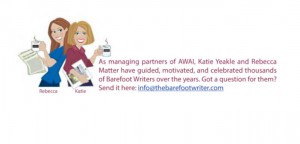Many writers look forward to the freedom of being a Barefoot Writer. They’re eager to do anything they want, when they want, and from where they want.
There’s just one thing standing in their way…
The fear of not having a predictable, steady income.
If this sounds like you — or if you want to make a more consistent income as a writer — I have great news!
There’s a way you can be a Barefoot Writer and make a predictable, steady income every month.
How?
Writing electronic newsletters (aka. e-newsletters or e-zines).
A Writing Niche Where Clients Pay You Month After Month and Stick Around for Years
One of the main benefits of writing e-newsletters is that the projects are extremely simple. They’re basically short, concise “articles in email form” sent from your client to their target audience, with the goal of keeping new prospects and existing customers engaged.
E-newsletters don’t do much selling. Instead, they take a non-salesy approach to building relationships with prospects. I like to say they “sell without selling.”
Like all the writing opportunities we introduce you to here in Barefoot Writer, this one offers the typical perks that come with living the writer’s life — from setting your own rates to working when and where you please.
But an additional perk to the world of email newsletters is the regularity with which clients will hire you — and then re-hire you. Most e-newsletters come out at least once a month. Others come out once a week, and some are even bi-weekly.
Once you establish yourself as an email-newsletter writer and impress a client with your work, it’s not unusual — quite typical, in fact — for that client to have you take over all subsequent email newsletters.
That means you have steady projects at regular intervals that you can count on every month. (And, the pay is great! But, I’ll get to that in just a minute.)
Why Are These Lucrative, Repeating Projects So Effective?
As a writing project, email newsletters tend to be short — much shorter than a long sales letter. In fact, these projects are so simple and short you can learn how to write them in just a few days. Then, with a little practice, you can complete each one in just a few hours.
But despite their brevity, e-newsletters are one of the most effective marketing tools for any business out there.
Why are they so effective? For starters, they’re interactive. E-newsletters can be forwarded to a friend. They have links to click on, questions that can be replied to. Readers might archive or make copies of them. In short, they’re engaging, which creates a valuable two-way dialogue between a business and its customers. Dialogues and engagement, of course, can increase sales.
According to MarketingSherpa, roughly 79% of new sales leads for businesses never convert into customers. While those sales leads showed an interest in a certain product or service, their interest was never encouraged. That’s where e-newsletters prove valuable. When interested customers, or leads, are taken by the hand and given more information, 47% will go on to make purchases, according to the Annuitas Group.
But, e-newsletters aren’t the newest thing in marketing. A lot of companies offer them. You probably subscribe to several, in fact.
At the same time, that’s what makes writing e-newsletters such a valuable opportunity to Barefoot Writers. Anybody can send out an email newsletter, but people are tired of reading self-promotional, “act-now” messages. They want something they can learn from, read enthusiastically, and enjoy over the long-term.
And That’s Where You, The Professional Writer Come In
So if short projects suit your writing style, each one offers the opportunity to write something that’s fun, quick, and often creative.
But it gets better…
With e-newsletters, there’s very little research required. In fact, one of the best approaches to e-newsletter research is to get your client on the phone for an hour and have them talk about something important in their business. Then, simply ask them to go into detail and share positive experiences, anecdotes, and even customer encounters.
Doing this opens up a bunch of new topics you can use, all from the perspective of your client. Before you know it, you’ve got enough content for a new issue — or even multiple issues. After all, your clients are the experts in their individual fields, so their perspective is often all you’ll need for a message that resonates.
This is another reason the Return On Investment is high in the e-newsletter world. It’s your client’s message that needs to come across clearly. So, as long as you know how to tap their knowledge, you’ll find it relatively easy to put together a newsletter their audience wants to read — and will respond to.
Email Communication is Alive and Well
Here’s another reason to love e-newsletters: They’re one of the most versatile projects you can pursue in the world of paid writing. They can be an extremely valuable communication tool for small businesses and big companies in any industry.
But, professional service providers especially benefit from e-newsletters. And, because there are 26 million professional service providers in the U.S. alone, you’ll have a ton of potential clients to choose from.
Professional service providers include anyone who offers their services or expertise for hire, so there’s likely to be a niche that fits your interests. Think about lawyers, accountants, chiropractors, therapists, personal coaches, real estate brokers, consultants, and even writers.
In fact, an email newsletter is an extremely useful tool for prospecting as you build your own writing business. It gives you the opportunity to not only showcase your writing, but also to show off your knowledge of the field.
Secrets to Writing an Effective E-Newsletter
Though it’ll vary between clients and industry, e-newsletter “issues” typically fall between 700 and 1,000 words. The communication style is typically informational, yet casual. And the more you sound like your client, the better.
Most email newsletters will be pure content. Your main job is to provide educational and informational copy. You can share advice, inspirational tidbits, and metaphors to keep your client’s name in front of their audience. At the same time, your copy should underscore their credibility and expertise.
Your goal when writing e-newsletters is to take whatever service or product your client offers and make it engaging. Stories are a particularly effective way to do this. So if your client sells real estate, you’d want to steer clear of “dry” topics in real estate — like square footage, or flexible floor plans — and instead talk about how to make a new house feel like a home, or tips for creating memories in your newly-purchased house.
In the marketing world, this is called “lead nurturing.” It’s not directly selling. Instead, the goal is to go for engagement, develop a relationship, and open up a dialogue.
Just Starting Your Writing Career? No Problem…
As for fees, you can charge between $450 and $1,500+ for each issue. The low-end would be appropriate for clients who prefer to write their own first drafts. The higher end is when you write the newsletter from beginning to end. So, even if you’re just starting out in the writing world and you charge on the low end, a weekly newsletter could bring you $1,800 a month. And once you’ve established yourself and have measurable results to show new clients, you can raise your fee.
You can also charge fees to help a client set up a new e-newsletter service, including layout, design templates, and color.
Or, charge a consulting fee for helping your client see the “bigger picture” by putting together a marketing plan and using the e-newsletter as a key tool in that plan.
If you don’t have a lot of writing experience under your belt… or even if you have none… this could be the niche for you. As Michael Katz, author of Creating Email Newsletters for Professional Service Firms says, “Anybody can write. But most people hate it. Imagine how happy you can make a prospective client when you take writing needs off their plate and deliver them higher sales in return.”
It’s not hard to learn the specifics of writing e-newsletters. Once you’ve done that, you’ll have a large pool of clients happy to use your services.
Enjoy This Writing Niche Where You “Sell Without Selling”
A huge draw to this kind of writing project is that email newsletters are straightforward and conversational — definitely not hypey. Like I said, the purpose of an e-newsletter is to stay in contact with customers and nurture sales leads. Although staying in touch with customers certainly has a marketing purpose, it’s not hard selling — far from it.
If you’re wondering how to get started writing e-newsletters from scratch, here are two approaches I recommend…
The first approach is to put together some samples. Pick out a product or company you like and write a sample series of e-newsletters for it. You don’t even have to pitch it to that company — just writing the sample to show to other prospective clients is enough.
Or, you can approach a company you’d like to write for and pitch them directly. Talk to them about the effectiveness of e-newsletters when it comes to growing relationships and nurturing leads (point out that nurtured leads produce a 20% average sales increase). Explain how staying in contact can make a huge difference in their bottom line, especially because it can reduce the expenses of other marketing efforts and provide a single channel for their message.
And once you’ve landed your first project, keep the ball rolling and go after other clients. Before you know it, you’ll have an entire e-newsletter writing business set up, complete with steady income and — best of all — access to the freedom that comes when you pursue the writer’s life.
Editor’s note: If you’re looking for more guidance on writing e-newsletters, I recommend you check out Creating Email Newsletters for Professional Service Firms. This program was created by the king of e-newsletters, Michael Katz, who teamed up with AWAI to help writers quickly learn how to craft e-newsletters that work. He explains how to build relationships, nurture leads, and bring in more sales.






